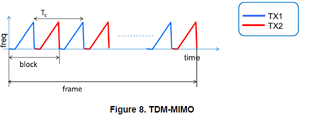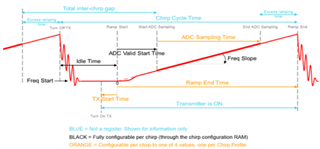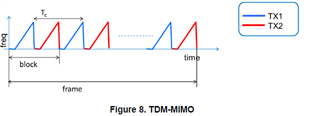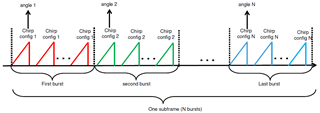Other Parts Discussed in Thread: AWR2243, , MMWCAS-DSP-EVM
Hello,
I am using the TI AWR2243 cascade board with the MMWCAS-RF-EVM (Rev-E) connected to the MMWCAS-DSP-EVM.
mmWave studio software: version 02_01_01_00
Firmware: mmwave_dfp_01_02_06_03
I am using the MATLAB examples for the TXBF and TDM MIMO modes. Let a frame denote the 4D matrix captured in a given time interval. I want to calculate exactly the frame interval or the number of frames per second. I want to control the frame rate with good accuracy. I spent some time and effort on my end reading the MATLAB scripts to understand the configuration parameters and how they can control the frame rate.
For the TXBF mode, for a burst-based beam steering frame structure, the 4D matrix is no samples per chirp x no chirp repetitions per loop x no of receivers (RXs) x no of steering angles. For the TDM MIMO mode, the 4D matrix is no samples per chirp x no chirp loops x no of receivers (RXs) x no of transmitters (TXs).
I have questions on two parameters:
A) Duty cycle: In the TXBF mode, in the chirpprofile_TXBF_USRR.m MATLAB script, line 75, what does the variable params.Dutycycle represent?
- Does it account for the OFF duration before and after the chirp ADC sampling time? or does it account for the OFF duration between bursts (Frame-based beam-steering) or loops (chirp-based beam-steering)? or there is another definition?
- Does the duty cycle follow the same definition in the TDM MIMO mode? or is it defined differently in the TDM mode? What is its definition in the TDM MIMO mode?
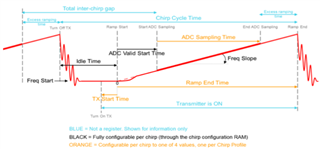
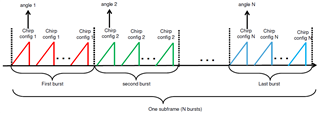
B) Inter_Frame_Interval: In the TDM MIMO mode, in the Cascade_configuration_MIMO.lua LUA script, line 87, what does the variable Inter_Frame_Interval represent?
- Does it represent the OFF duration between frames (the time interval between the end of one frame and the start of the next frame)? or does it represent the frame repetition period (the time interval between the ON start of one frame and the ON start of the next frame)? or there is another definition?
- Based on the answer to the previous question, and knowing the frame ON duration, how small can we set the OFF duration between frames? Is there any hardware constraint involved? If any, what are these constraints?
Thank you for your help!
